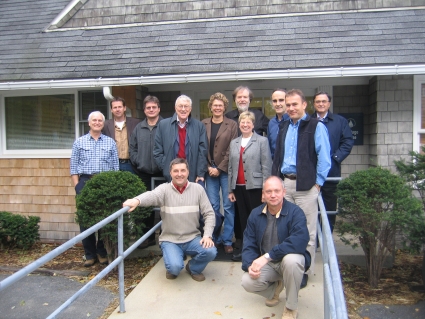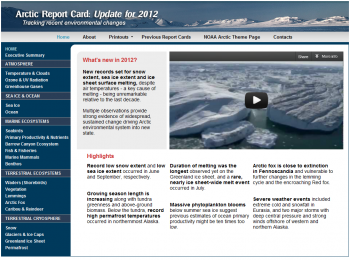The Arctic Report Card is an annually updated, peer-reviewed source for concise environmental information on the current state of the Arctic relative to historical records. It is intended for a wide audience including scientists, teachers, students, decision-makers, and the general public. Support for the Arctic Report Card is provided by the National Oceanic and Atmospheric Administration (NOAA) Climate Program Office through the Arctic Research Program.
History and Purpose
The Arctic Report Card got its start at a small workshop in 2005 that was hosted by Woods Hole Oceanographic Institute (WHOI) and funded by NOAA. The workshop had been proposed by Jackie Richter-Menge of the Cold Regions Research and Engineering Laboratory (CRREL) and Jim Overland of NOAA/Pacific Marine Environmental Laboratory (PMEL). The primary goal of the workshop was to create a comprehensive baseline report describing the state of the Arctic, plus a methodology for producing annual reports in the future. From the start, the intent was to keep the report short, straightforward, and to highlight observational data rather than model reports.

As a result of the workshop, the NOAA Climate Program Office introduced the State of the Arctic Report in 2006, which established a baseline of conditions from the previous five years (2000-2005) relative to those in the latter part of the 20th century. This benchmark assessment was based on data obtained from U.S. and international sources. The 2006 report described pan-arctic atmosphere, ice, ocean, and land variables. This report is now updated annually as the Arctic Report Card to monitor changing conditions in the Arctic.
Developing Report Card Content
Producing the annual Arctic Report Card involves the cooperation and coordination of many groups of people and organizations. The editorial team is presently Martin Jeffries, (lead editor; Office of Naval Research), Jackie Richter-Menge, and Jim Overland. Each year, the editorial team identifies section coordinators for the main sections of the report. Each section consists of an overall summary written by the section coordinator and individual topical essays composed and prepared by separate writing teams. The editorial team works with the section coordinators to identify the essay topics that will be included in each section and to select lead authors for each essay. The lead authors select their writing team, with a focus on incorporating a strong international perspective.
The current Arctic Report Card is organized into five sections: Atmosphere, Sea Ice and Ocean, Marine Ecosystems, Terrestrial Ecosystems, and Terrestrial Cryosphere. Essay topics vary from year to year depending on the availability of data. For example, annual essays on sea ice are possible because satellites obtain frequent data over large areas, whereas annual updates to marine and terrestrial ecosystem topics are constrained by more limited data availability.
The review process begins with an internal review. The editorial team, section coordinators, and lead essay authors examine the first draft of the Report Card content. Next, the draft report is sent to the NOAA Arctic Project Office, which works in conjunction with the Arctic Monitoring and Assessment Programme (AMAP) to conduct an external, anonymous peer-review. The content undergoes several iterations in response to the peer-review input. The entire Report Card is presented online; Nancy Soreide and Tracey Nakamura from NOAA/PMEL are responsible for creating the report website and video. Further outreach is led by Jana Goldman in NOAA's Public Affairs Office, who organizes the annual public release of the Report Card. The report is also recognized as a contribution to the Study of Environmental Arctic Change (SEARCH).
The 2012 Arctic Report Card

The 2012 Arctic Report Card was released on 5 December 2012 at an American Geophysical Union fall meeting press conference led by Dr. Jane Lubchenco, Under Secretary of Commerce for Oceans and Atmosphere and Administrator of NOAA. The 2012 Report Card contains 20 essays by 141 scientists from 15 countries. Highlights include:
- Record low snow extent and low sea ice extent occurred in June and September, respectively.
- Growing season length is increasing along with tundra greenness and above-ground biomass. Below the tundra, record high permafrost temperatures occurred in northernmost Alaska.
- Duration of melting was the longest observed yet on the Greenland ice sheet, and a rare, nearly ice sheet-wide melt event occurred in July.
- Massive phytoplankton blooms below summer sea ice suggest previous estimates of ocean primary productivity might be ten times too low.
- Arctic fox is close to extinction in Fennoscandia and vulnerable to further changes in the lemming cycle and the encroaching Red fox.
- Severe weather events included extreme cold and snowfall in Eurasia, and two major storms with deep central pressure and strong winds offshore of western and northern Alaska.
On its release, the 2012 Report Card website was accessed from 19,851 unique sites in 105 countries; 4,765 websites referred to the Report Card and the YouTube video has been viewed 32,404 times.
To view the 2012 Arctic Report Card, the YouTube video, and previous report cards, please visit the NOAA website.
For more information regarding the Arctic Report Card, please contact Jana Goldman, NOAA Communications & NOAA Research, at jana.goldman [at] noaa.gov or 301-734-1123.
Many thanks to Jackie Richter-Menge and Martin Jeffries for their contributions to this article.
References
Jeffries, M. O., J. A. Richter-Menge and J. E. Overland, Eds., 2012: Arctic Report Card 2012.
